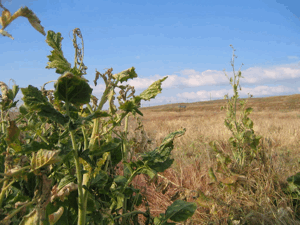My Planet Harmony
Air Date: Week of May 28, 2010

The arid soil of Central California is a haven for bacterial spores that cause respiratory problems. (Photo courtesy of: Mwende Hahsey)
Living on Earth has been featuring stories every week from its sister program, Planet Harmony. The new offering follows environmental issues facing communities of color. Reporter Mwende Hahsey explains why she doesn’t consider herself to be an environmentalist but is still compelled to tell stories about the state of her environment.
Transcript
YOUNG: It’s Living on Earth, I’m Jeff Young. For the past month we’ve been featuring stories from our new online offering, Planet Harmony. We've heard reports from all over the country about communities often under-represented in environmental decision-making. Well, today, one of our Planet Harmony reporters has some thoughts on the importance of bringing more voices to environmental conversation.
HAHESY: Hey this is Mwende Hahesy and I’m sitting here next to the Pacific Ocean on Westcliffe Beach, in Santa Cruz, California. I don’t consider myself an environmentalist; it’s just the state of the environment has a lot to do with the health of my family and friends. The health of a community can be measured through the health of its environment. And to me, no other community lives up to this more than the one I grew up in.

Mwende Hahsey reports for Planet Harmony from her new home in Santa Cruz. (Photo courtesy of: Mwende Hahsey)
I was raised in the San Joaquin Valley in Central California. When you drive through the Valley, as we like to call it, you pass through an endless succession of alfalfa fields, orange trees and dairies. It’s a pastoral piece of Americana. On the flip side, the Valley has some of the highest rates of obesity and childhood asthma in the country. And these rates are even worse for people of color. So then I have to take a step back and remind myself to give things a second look.
When I was a kid, I had severe asthma. But I was hardly a special case. I remember my daily midday asthma treatment at school. I would stand in line outside the nurse’s office and wait with at few other kids who were almost exclusively Latino.

The arid soil of Central California is a haven for bacterial spores that cause respiratory problems. (Photo courtesy of: Mwende Hahsey)
We never really thought much of it; this was simply a fact of life. But the older I got, the more this general acceptance bugged me. The Valley was my home but it made me sick. Now that I’m older I see all the signs around me: the thick layer of smog on the horizon and the crop dusters that drop pesticides on fields near housing developments. Valley residents are unhealthy because of these very things. Why wasn’t anyone angry?
Planet Harmony has created a space. Now we can follow underrepresented communities’ struggles and accomplishments in environmental and health issues across the country and the globe.
YOUNG: Mwende Hahesy reports for Planet Harmony. Planet Harmony welcomes all and pays special attention to issues affecting communities of color. Check out more from Mwende and contribute your own thoughts, ideas and stories at My Planet Harmony dot com. That's my planet harmony dot com.
Links
Living on Earth wants to hear from you!
Living on Earth
62 Calef Highway, Suite 212
Lee, NH 03861
Telephone: 617-287-4121
E-mail: comments@loe.org
Newsletter [Click here]
Donate to Living on Earth!
Living on Earth is an independent media program and relies entirely on contributions from listeners and institutions supporting public service. Please donate now to preserve an independent environmental voice.
NewsletterLiving on Earth offers a weekly delivery of the show's rundown to your mailbox. Sign up for our newsletter today!
 Sailors For The Sea: Be the change you want to sea.
Sailors For The Sea: Be the change you want to sea.
 The Grantham Foundation for the Protection of the Environment: Committed to protecting and improving the health of the global environment.
The Grantham Foundation for the Protection of the Environment: Committed to protecting and improving the health of the global environment.
 Contribute to Living on Earth and receive, as our gift to you, an archival print of one of Mark Seth Lender's extraordinary wildlife photographs. Follow the link to see Mark's current collection of photographs.
Contribute to Living on Earth and receive, as our gift to you, an archival print of one of Mark Seth Lender's extraordinary wildlife photographs. Follow the link to see Mark's current collection of photographs.
 Buy a signed copy of Mark Seth Lender's book Smeagull the Seagull & support Living on Earth
Buy a signed copy of Mark Seth Lender's book Smeagull the Seagull & support Living on Earth

